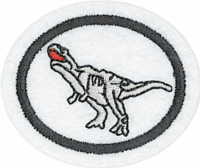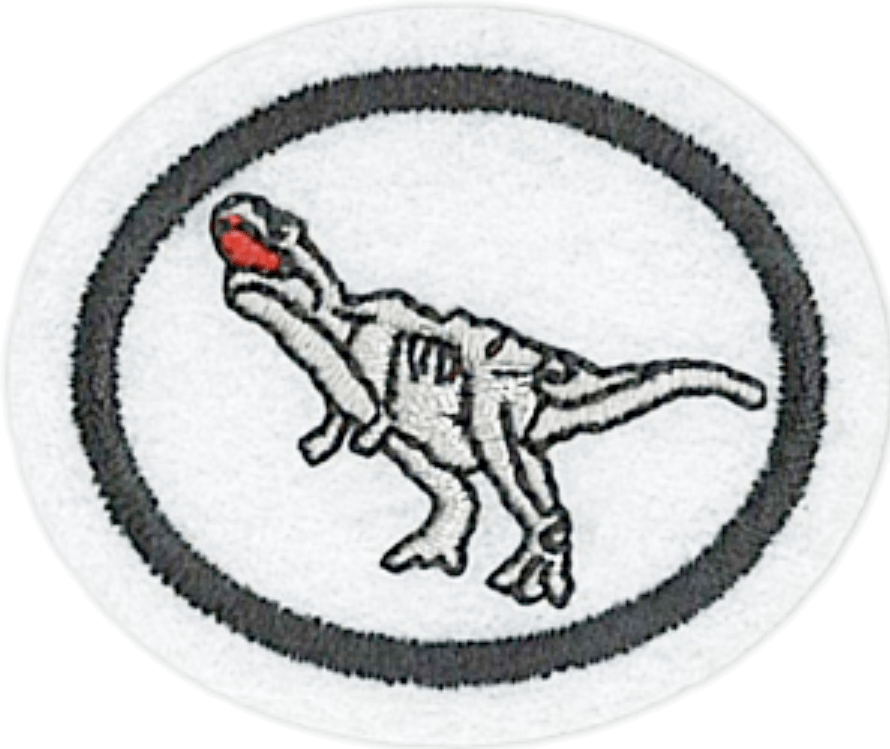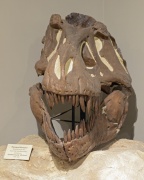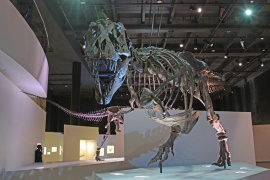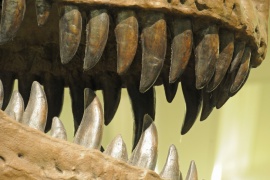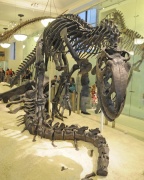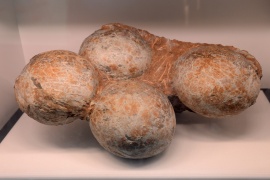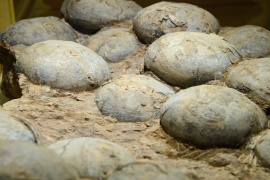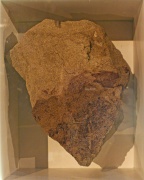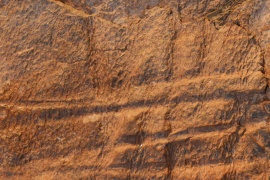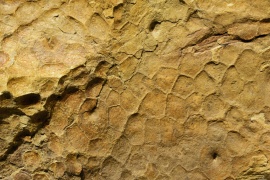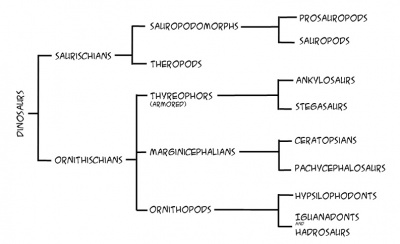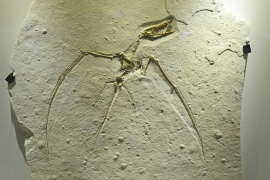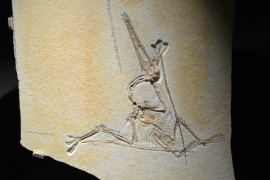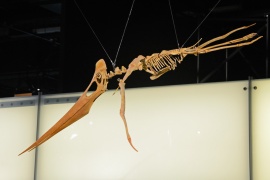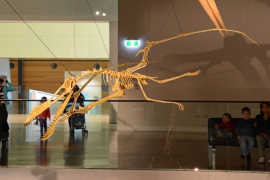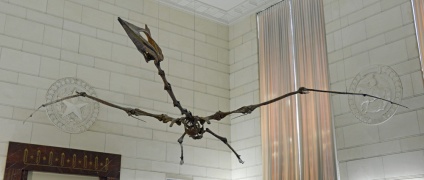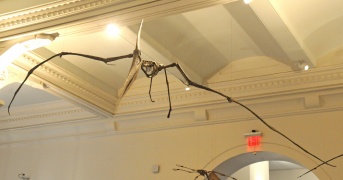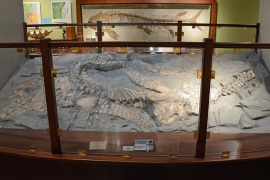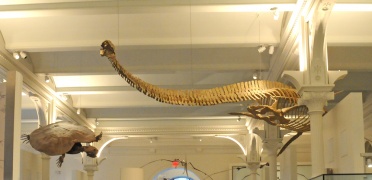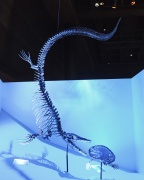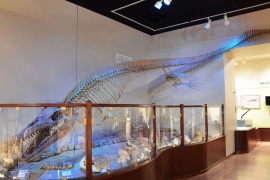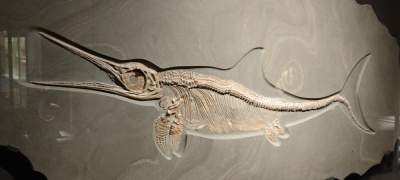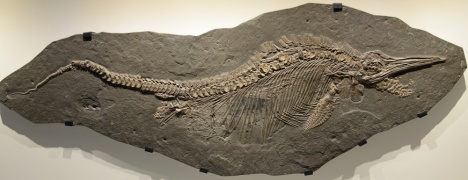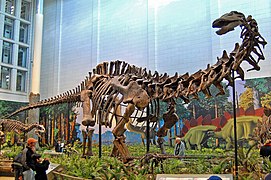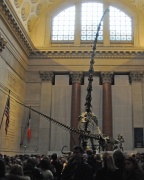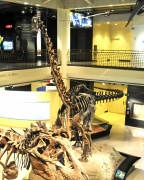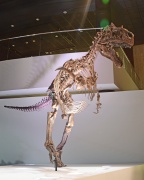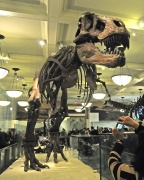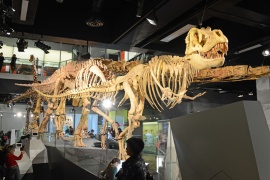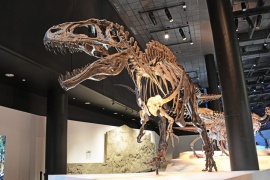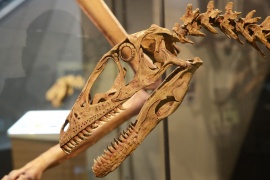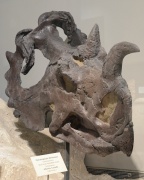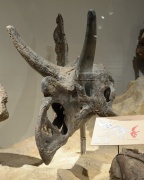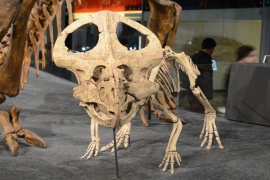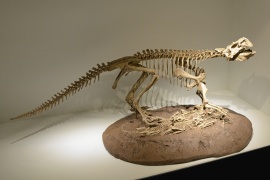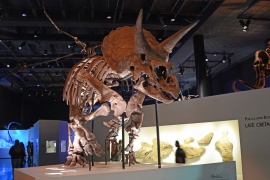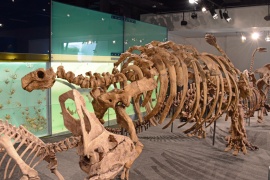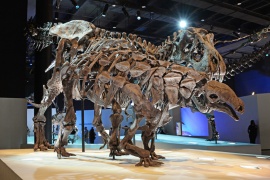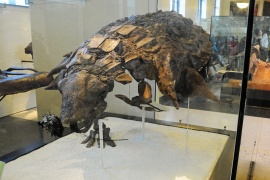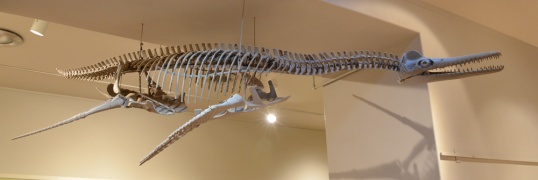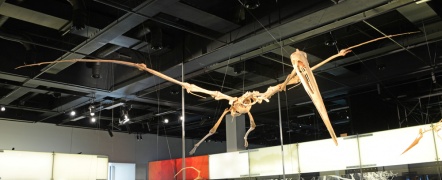Respuestas para la especialidad JA de Dinosaurios
1
The word Dinosaur is a Latinized combination of the Greek roots “deinos” [terrible] and “sauros” [lizard] - so the word means Terrible Lizard. Sir Richard Owen, a British anatomist and taxonomist, coined the term in the early 1840s after determining that a set of fossil bones he studied, including those of Iguanodon and Megalosaurus, were not lizards, but something uniquely different.
There are several common characteristics of dinosaurs that separate them from other reptiles. Dinosaurs are terrestrial, have an upright posture (as opposed to most reptiles with offset limbs), a strong knee and ankle joint, and were diapsids (have two openings in the skull behind the eyes) with an additional hole on each side of the skull in front of the eyes (the antorbital fenestrae) and a hole on each side of the lower jaw (the mandibular fenestrae).
2
One of the first steps in dinosaur reconstruction is comparative anatomy. Because bones often have analogous features, functions and articulation, paleontologists can make a first set of assumptions about the size, shape and gait of the dinosaur, even with only a small number of bones. Close investigation of bones can reveal signs of muscle attachment, which can further give shape to the dinosaur. Paleontologists also use comparative anatomy to see basic forms of animals in similar environments, using clues from the rock and other fossils around the dinosaur bones to infer a particular ecosystem, and looking at modern animals that live in similar ecosystems for potential models. In some cases, impressions of skin and feathers can offer some clues as to the external appearance. Although there is no fossilization of color, paleontologists can draw some inferences from patterns and colors in modern animals that live in similar ecosystems or have similar lifestyles.
3
3a
The Tyrannosaurus rex was the top predator/consumer in its environment. Just as the Lion is the “King” in its modern environment, so too the T. rex and its likes were “King” species. The T. rex was particularly notable for its very large head/jaws which suggest significant biting power, and its large teeth. T. rex is found in Upper Cretaceous deposits in North America. The pictures below showcase the jaws and teeth of this king dinosaur.
What other dinosaurs are also considered dominate “king” species?
Other Tyrannosaurs are considered “King” species, such as the Albertosaurus and Tarbosaurus. The various Carnosaurs, such as Allosaurus (below) and Acrocanthosaurus (whose tracks can be seen in Texas), were also “King” species in their environments.
3b
Many modern reptiles are egg layers, as are modern birds, which according to evolutionists are related to the dinosaurs. Fossilized dinosaur eggs have been found, offering evidence that at least some of the dinosaurs were egg layers.
The dinosaur eggs below are from China:
3c
Although much rarer than fossilized bones, skin prints from dinosaurs have also been found in the fossil record. Many prints highlight bumpy skin, small or large non-overlapping scales and in some species bony plates. Hadrosaurs have some of the best preservation of skin prints, showing non-overlapping bumpy scales, sometimes nearly hexagonal in shape. Dinosaurs like Stegosaurus had bony plates on their skin, possibly for protection, thermoregulation, sexual advertising or a combination of the three. The Ankylosaur had osteoderms - bony projections and plates - embedded in its skin that provided a complete armor coating.
Below are three samples of fossilized Dinosaur skin, from left to right: Hadrosaur skin (displayed at the Melbourne Museum, Australia), Edmontosaurus skin, and Triceratops skin (the latter two displayed at the Houston Museum of Natural Science)
3d
Dinosaurs are in general divided into two groups, the Ornithischians (“Bird-Hipped” dinosaurs), and the Saurischians (“Lizard-Hipped” dinosaurs). These groups are distinguished primarily by the differences in the arrangement of their pelvic bones.
Each of these groups are further sub-divided based on otehr common characteristics. The Saurischians are divided into the Theropods (“Beast-Footed” Dinosaurs) such as Tyrannosaurus Rex and Deinonychus, which were primarily bipedal carnivores, and the Sauropodomorphs (“Lizard-Foot Form” Dinosaurs), which were primarily bipedal and quadrupedal herbivores. The Sauropodomorphs are further subdivided into the primarily bipedal Prosauropods and their much larger and well known cousins the Sauropods, which include the largest of the land animals, such as Diplodocus, Seismosaurus and Apatasaurus.
The Ornithischians are divided into three subgroups: the Thyreophors (armored dinosaurs including the various Ankylosaurs and Stegasaurs), the Marginicephalians (which include the quadrupedal herbivore Ceratopsians like triceratops and the mostly bipedal dinosaurs with thickened skull bones like a helmet, the Pachycephalosaurs) and the Ornithopods (which include the smaller herbivores the Hypsilophodonts, and their larger cousins the Iguanodonts and Hadrosaurs).
In which two groups are they divided?
Sauropodomorphs are divided into two categories. The smaller prosauropods (“Before Lizard-Foot” Dinosaurs), were mostly herbivorous bipedal early dinosaurs from the Late Triassic to Early Jurassic, including Saturnalia and Thecodontosaurus. The larger Sauropods (“Lizard-Foot” Dinosaurs) in some cases grew to massive size, and were characterized by long necks and tails, relatively small heads, primarily a quadrupedal gait, and a generally herbivorous diet. Sauropods include Apatasaurus (once called Brontosaurus), Brachiosaurus, and Saltasaurus.
3e
Dinosaurs are properly those animals included in the Superorder Dinosauria, a group of terrestrial reptiles characterized by their stance, by stronger ankle and knee joints, and by antorbital and mandibular fenestrae. Marine and flying reptiles come from different lines of reptiles.
The flying reptiles (in the Order Pterosaurs, or “Winged Lizards”)
Marine reptiles are in several groups, including the Superorder Ichthyopterygia and the Superorder Sauropterygia. The marine reptiles pictured below, beginning from top left: two Plesiosaurs, two Mosasaurs, and two Ichtyosaurs.
4
You can combine your research for question 4 and 7. Rather than just a food chain (which is effectively a linear set of connections - a primary producer, a primary consumer, a secondary consumer, perhaps a tertiary consumer), consider a food pyramid (which provides several variations at the base, working up to fewer species at the higher levels - a closer representation to nature than a single line), or a food web, which highlights the complexity of ecological systems.
"La cadena alimentaria de los dinosaurios. La flecha color malva la alimentación de los insectos; verde, la comida del lagarto; amarilla, la de los omnívoros; naranja la de los ornithomimidos; azul los dromaeosaurios; y rosa, la del Tyranosaurio. Los tres últimos eran dinosaurios carnívoros."
5
5a
Means "lizard-footed", are an infraorder of saurischian ("lizard-hipped") dinosaurs. They had very long necks, long tails, small heads (relative to the rest of their body), and thick, pillar-like legs. They are notable for the enormous sizes attained by some species, and the group includes the largest animals to have ever lived on land.
5b
Theropods were commonly bipedal, with a relatively large head and a counter-balancing tail. These were primarily carnivorous, and include the Tyrannosaurus Rex.
Examples of Teropods:
5c
Ceratopsians (Marginocephalians) were primarily quadrapedal ornithischians, characterized by a bony frill at the back of the head, and often horns on the face.
Examples of Ceratopsians below:
5d
The Ankylosaurs are one of the characteristic forms of the Thyreophors, or armored dinosaurs. They were low-slung, had various armored plates on their backs, and often had a club or other armored element on their tails. Other Thyreophors include the Stegosaurs, which had bony plats on their backs and spikes on their tails.
5e
Plesiosaurs were marine reptiles, with an oval body, a long tail and neck, and flippered limbs.
5f
Pterosaurs were flying marine reptiles, with membraneous wings, frequently with short or minimal tails (though not always), and often with counterbalancing horns on their heads.
Below is one of the larger Pterosaurs. Other Pterosaurs are pictured above.
6
6a
20 And God said, “Let the water teem with living creatures, and let birds fly above the earth across the vault of the sky.” 21 So God created the great creatures of the sea and every living thing with which the water teems and that moves about in it, according to their kinds, and every winged bird according to its kind. And God saw that it was good. 22 God blessed them and said, “Be fruitful and increase in number and fill the water in the seas, and let the birds increase on the earth.” 23 And there was evening, and there was morning—the fifth day. 24 And God said, “Let the land produce living creatures according to their kinds: the livestock, the creatures that move along the ground, and the wild animals, each according to its kind.” And it was so. 25 God made the wild animals according to their kinds, the livestock according to their kinds, and all the creatures that move along the ground according to their kinds. And God saw that it was good.
There are a number of other Bible texts that mention reptiles.
6b
Fossils of dinosaurs have been discovered around the world. There are also fossilized dinosaur footprints.
6c
i
ii
6d
The Biblical Flood found in Genesis would explain how many dinosaurs could be quickly killed and buried to be preserved as fossils. If an animal dies and is not buried quickly under extreme conditions it does not usually fossilize. Even evolution believing scientists agree that dinosaurs were killed off in a global catastrophe. The big debate is when the catastrophe occurred.
7
You can work on this research when you investigate question 4. The purpose here is to do more than describe the basic characteristics of the dinosaur, but to consider them in a living environment, as you would with a modern extant animal. This requires study of the plant life, other dinosaurs and other animals that would have lived in the same area, and consider the way they they would have interacted.
7a
7b
7c
8
8a
8b
8c
8d
We provide some examples but searching natural history museum websites will yield good information as will searching Wikipedia. Be careful with the scientific estimations of the age of specimans which do not match God's Word. This should be discussed with Pathfinders studying dinosaurs.
References
The Dino Database ([1]) has a list of museums in the United States that display dinosaurs. Although not necessarily a complete list, this provides a good start to find dinosaur fossils in your area. You may also consider contacting nearby universities, if there are no museums in your area.
